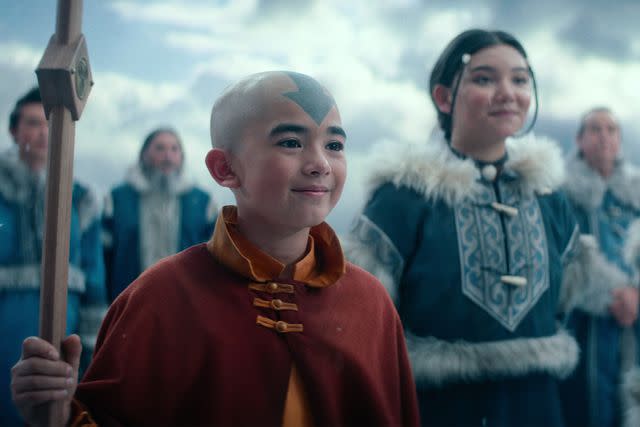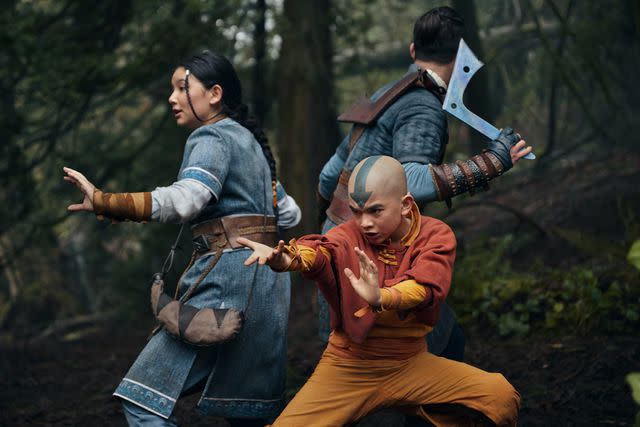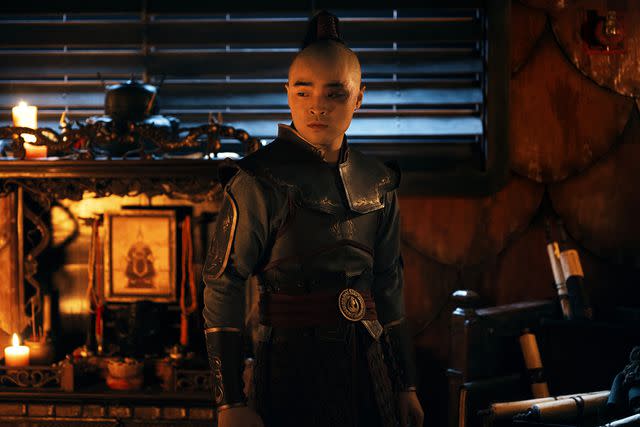Netflix’s “Avatar: The Last Airbender” sparks but never blazes as bright as the original

- Oops!Something went wrong.Please try again later.
- Oops!Something went wrong.Please try again later.
- Oops!Something went wrong.Please try again later.
The beloved Nickelodeon show gets a new live-action adaptation — one that’s blessedly better than M. Night Shyamalan's version.
When Netflix announced plans to adapt Avatar: The Last Airbender back in 2018, fans met the news with curiosity and a significant dose of skepticism. For some, a live-action adaptation of one of the most beloved animated shows of all time seemed like a no-brainer, a chance to finally right the wrongs of M. Night Shyamalan’s ugly and misguided 2010 attempt. For other fans, the very notion of adaptation was sacrilege: The original show, which ran from 2005 to 2008 on Nickelodeon, is widely hailed as one of the greatest animated series of the 21st century, an ambitious, anime-inspired saga that blended gorgeous world-building and thoughtful storytelling. (It’s certainly one of the few kids' TV shows to deftly tackle themes of morality, imperialism, and self-determination.) As the Netflix premiere date crept closer and fans continued to bicker online, a general consensus began to emerge: How could any live-action adaptation possibly live up to the charms of the original animated series? And how could it be any worse than the previous attempt?
Perhaps unsurprisingly, Netflix’s Avatar falls somewhere in the middle. The series arrives more than a half-decade after it was first announced, with a new creative team and cheery young cast of newcomers. The result is a charming but imperfect adaptation that vastly improves upon the 2010 film — but never soars quite as high as the original animated show.

Netflix
Gordon Cormier as Aang and Kiawentiio as Katara in 'Avatar: The Last Airbender'Hollywood loves a live-action version of a beloved animated IP, and previous Netflix attempts have varied from decent (One Piece) to decidedly mediocre (Cowboy Bebop). The new Avatar follows a similar model, hewing closely to the plot of the original series even as it trades 20-minute episodes for sprawling, hour-long installments. Heavily inspired by real-world Asian and Indigenous cultures, the world of Avatar is divided into four nations — water, earth, fire, and air — where some residents can manipulate or “bend” a chosen element. The power-hungry Fire Nation disrupts years of peace when it wages war against the other nations, slaughtering the peaceful Air Nomads and kickstarting 100 years of violence. But a savior emerges in the form of the Avatar, a powerful figure who can wield all four elements and is reincarnated with every new generation. The latest incarnation is a 12-year-old airbender named Aang (Gordon Cormier), an optimistic daredevil who has to balance global responsibility with the pressures of being a preteen.
After Aang wakes from a 100-year sleep at the South Pole, he sets out on a journey to master all four elements, joined by waterbending friend Katara (Kiawantiio) and her boomerang-wielding brother Sokka (Ian Ousley, who gets some of the show’s best one-liners). Accompanied by Aang’s trusty flying bison Appa, the trio crisscrosses the countryside — all while being hunted by the exiled Fire Nation prince Zuko (Dallas Liu). The young Zuko has been tasked with finding and capturing the Avatar, all in an attempt to impress his domineering father, the sinister Fire Lord Ozai (played byDaniel Dae Kim, who voiced roles in the original series and its spinoff The Legend of Korra).
Together, the young members of Team Avatar have a sparkling chemistry, bantering and bonding as they zoom through the air on Appa’s back. (Unlike the Shyamalan version, this Avatar insisted on casting exclusively Asian and Indigenous actors.) Cormier in particular brings a wide-eyed wonder to the naïve Aang, who’s juggling the pressure of saving the world with the fact that he’s, well, 12. The original show excelled at melding thrilling action with introspective moral dilemmas, and Cormier deftly handles some of the show’s more serious moments.

Robert Falconer/Netflix
Katara (Kiawentiio), Aang (Gordon Cormier), and Sokka (Ian Ousley) in 'Avatar: The Last Airbender'But even with charming lead performances, the show’s biggest weakness is its style: For adapting such a gorgeous piece of animation, Avatar looks surprisingly drab in places. Part of what made the original series so magical was its lavish world-building, tracking Team Avatar as they journeyed from arctic oceans to bustling cities to lush, verdant forests. The Netflix show retraces those same steps, replacing hand-drawn animation with CG spectacle — and the effect is considerably less impressive. The series clearly relies on the same StageCraft “Volume” technology that’s been popularized by Star Wars and Marvel projects, and as a result, the show trades its unique visual style for the same glossy, uninspired sheen that looks like everything else on TV right now. There are a few bright spots: In one early episode, Aang and Katara practice waterbending by an actual river, scooping up fistfuls of water to playfully splash each other. (The series filmed in British Columbia.) Watching the actors actually interact with the world around them — especially in a show that’s literally about harmony with nature — just serves to make the over reliance on the Volume that much more blatant.
The story itself sticks closely to the plot of the original series, but the new scripts do make a few thoughtful adjustments: One smart decision is introducing Zuko’s unhinged sister Azula (Elizabeth Yu) as early as possible, instead of saving her for season 2 (as the original series does). Like Zuko, Azula is desperate for the attention of their domineering father, pushing her fiery powers to the limit and scheming ways to unseat her brother. Ozai himself also looms large throughout the season, and Kim brings a regal, paternalistic malice to the role, stalking through war rooms and palace hallways with unsettling regality. These early peeks into the Fire Nation add depth to Zuko’s fractured family and his single-minded quest to come home. And Liu is excellent as the tortured young prince, torn between his father’s harsh mandates and the softer guidance of his Uncle Iroh (Paul Sun-Hyung Lee).

Animated series creators Bryan Konietzsko and Michael Dante DiMartino were originally attached to helm the Netflix show, before departing in 2020 due to “creative differences.” New showrunner Albert Kim soon took over, and Kim has spoken reverently about his admiration for the original series. His adoration is clear on screen, and many of the show’s highlights are faithfully recreated in live-action, from the crowded streets of the Earth Kingdom city Omashu to the ethereal forests of the Spirit World. Indeed, the series packs each episode with Easter eggs that are sure to delight fans, including a certain familiar earworm and the return of everyone’s favorite cabbage merchant. The new Avatar is clearly a labor of love, but its very existence raises the question: Who, exactly, is this for? Cast and creators alike have teased this version as being “slightly darker” than the original series, and the very first episode kicks off with the Fire Nation brutally massacring the monks of Aang’s air temple (an event that was described in the original series but depicted off screen). The writers — clearly guided by Netflix oversight — are aiming for an all-ages adventure, targeting both nostalgic millennials and a new generation of preteen fans.
But a show needs more reason to exist than just retreading a fan favorite. The best adaptations have some sort of thesis statement, responding to their source material with the narrative equivalent of a “Yes, And.” (To look at Disney, another studio that has embraced the animation-to-live-action pipeline, think of the difference between inventive fare like Pete’s Dragon and the soulless 2019 Lion King remake, which exists only to imitate.) Netflix’s Avatar is so faithful to the original series that it automatically invites comparison — a comparison where it inevitably comes up short. If the two shows are too similar, why would anyone bother to watch the live-action show at all?
There is potential here. Drab visuals aside, the actual bending scenes are a vast improvement over Shyamalan’s version, and there’s a distinct thrill in watching characters lob fireballs, raise walls of solid rock, or freeze ocean waves into spiky shards of ice. The cast also elevates every conversation and fight scene, and the main kids seem just as comfortable grappling with heavy themes as they do executing a backflip. After bingeing the season’s eight episodes, I found myself imagining how actors like Cormier or Liu might only continue to grow, especially when tackling plot points from later seasons. (And besides, I can’t be the only fan longing to see favorites like Toph Beifong back on screen.)
Hopefully, Netflix’s Avatar proves to be a bit like its titular hero — still early in its journey, with great potential on the horizon. As Aang comes to learn, he contains the souls of every Avatar to come before him, and he often leans on them for insight and advice. Past incarnations can be a useful guidepost, but eventually, every Avatar needs to find their own voice, too. Grade: B-
Sign up for Entertainment Weekly's free daily newsletter to get breaking TV news, exclusive first looks, recaps, reviews, interviews with your favorite stars, and more.
Related content:
A new Avatar awakens: Inside The Last Airbender’s live-action reincarnation
Daniel Dae Kim sees Fire Lord Ozai as the Darth Vader of Avatar
Read the original article on Entertainment Weekly.

